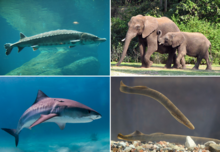Vertebrate
A vertebrate is an animal with a spinal cord surrounded by cartilage or bone. The word comes from vertebrae, the bones that make up the spine. Animals that are not vertebrates are called invertebrates. Vertebrates include birds, fish, amphibians, reptiles, and mammals. The parts of the vertebrate skeleton are:
- Braincase: A braincase or cranium protects the brain.
- Vertebrae: A series of short, stiff vertebrae are separated by joints. This internal backbone protects the spinal cord. The joints between the vertebrae let the backbone bend.
- Bones: support and protect the body's soft tissues and provides points for muscle attachment.
- Gill arches: Gill arches in the pharynx of fish and some amphibians support the gills. In the majority of vertebrates some of the arches have evolved into other organs, such as jaws.
| Vertebrate | |
|---|---|

| |
| Example of vertebrates: Acipenser oxyrinchus (Actinopterygii), an African bush elephant (Tetrapoda), a Tiger shark (Chondrichthyes) and a River lamprey (Agnatha). | |
| Scientific classification | |
| Domain: | Eukaryota |
| Kingdom: | Animalia |
| Superphylum: | Deuterostomia |
| Phylum: | Chordata |
| Clade: | Olfactores |
| Subphylum: | Vertebrata J-B. Lamarck, 1801[2] |
| Infraphylums | |
| Synonyms | |
|
Ossea Batsch, 1788[2] | |

Examples of vertebrates are mammals, birds, and fish. A few tens of thousands of species have been identified. The term "fish" is used to describe at least four different kinds of vertebrates.
Distinctions change
Vertebrates dominate amongst the animals in virtually all environments. They include the largest animals in each main ecosystem, though not the largest living things (because that would include trees). They are the only animals which have an adaptive immune system.[3] These two facts may be connected.
Taxonomy and classification change
- Subphylum Vertebrata
- Agnatha (jawless vertebrates)
- †Conodonta
- †Pteraspidomorphi
- †Thelodonti
- †Anaspida
- †Galeaspida
- †Pituriaspida
- †Osteostraci
- Gnathostomata (jawed vertebrates)
- †Placodermi (Paleozoic armoured forms)
- Chondrichthyes (cartilaginous fish)
- †Acanthodii (Paleozoic "spiny sharks")
- Osteichthyes (bony fish)
- Actinopterygii (ray-finned fish)
- Sarcopterygii (lobe-finned fish)
- Coelacanthimorpha (coelacanths)
- Dipnoi (lungfish)
- Tetrapoda (four-limbed vertebrates)
- Amphibia (amphibians)
- Amniota (amniotic eggs)
- Sauropsida (reptiles and birds)
- Lepidosauria (lizards, snakes and tuatara)
- Testudines (turtles)
- Archosauria (archosaurs)
- Crocodilia (crocodilians)
- †Pterosauria (pterosaurs)
- Dinosauria (dinosaurs)
- Aves (birds)
- Synapsida (mammal-like tetrapods)
- Sauropsida (reptiles and birds)
Related pages change
References change
- ↑ Yang, Chuan; Li, Xian-Hua; Zhu, Maoyan; Condon, Daniel J.; Chen, Junyuan (2018). "Geochronological constraint on the Cambrian Chengjiang biota, South China" (PDF). Journal of the Geological Society. 175 (4): 659–666. Bibcode:2018JGSoc.175..659Y. doi:10.1144/jgs2017-103. ISSN 0016-7649. S2CID 135091168.
- ↑ 2.0 2.1 Nielsen, C. (July 2012). "The authorship of higher chordate taxa". Zoologica Scripta. 41 (4): 435–436. doi:10.1111/j.1463-6409.2012.00536.x. S2CID 83266247.
- ↑ Janeway C.A. 2001. Evolution of the immune system. In Immunobiology ed Janeway et al. 5th ed, 597–607. New York: Garland Science. ISBN 978-0-8153-4101-7